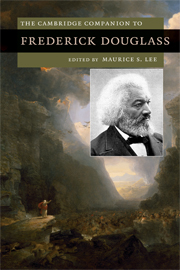Book contents
- Frontmatter
- Introduction
- 1 Douglass’s Self-Making and the Culture of Abolitionism
- 2 Identity in the Autobiographies
- 3 Douglass as Orator and Editor
- 4 Crisis and Faith in Douglass’s Work
- 5 Violence, Manhood, and War in Douglass
- 6 Human Law and Higher Law
- 7 Sentimental Douglass
- 8 Douglass among the Romantics
- 9 Douglass’s Black Atlantic: Britain, Europe, Egypt
- 10 Douglass’s Black Atlantic: The Caribbean
- 11 Douglass, Ideological Slavery, and Postbellum Racial Politics
- 12 Born into Slavery: Echoes and Legacies
- Guide to Further Reading
- Index
7 - Sentimental Douglass
Published online by Cambridge University Press: 28 July 2009
- Frontmatter
- Introduction
- 1 Douglass’s Self-Making and the Culture of Abolitionism
- 2 Identity in the Autobiographies
- 3 Douglass as Orator and Editor
- 4 Crisis and Faith in Douglass’s Work
- 5 Violence, Manhood, and War in Douglass
- 6 Human Law and Higher Law
- 7 Sentimental Douglass
- 8 Douglass among the Romantics
- 9 Douglass’s Black Atlantic: Britain, Europe, Egypt
- 10 Douglass’s Black Atlantic: The Caribbean
- 11 Douglass, Ideological Slavery, and Postbellum Racial Politics
- 12 Born into Slavery: Echoes and Legacies
- Guide to Further Reading
- Index
Summary
In his 1845 Narrative, Frederick Douglass recalls how, as a small child, he had “often been awakened at the dawn of day by the most heart-rending shrieks of an own aunt of mine” (N 18). In particular, he recollects that the first time he witnessed his Aunt Hester being whipped possessed an especially “awful force,” declaring that he “shall never forget it whilst I remember any thing.” Living with his grandmother on the “outskirts of the plantation,” Douglass had been sheltered from “the bloody scenes” of slavery, and thus this “horrible exhibition” marks - both literally and figuratively - the mythic moment that the child comes into consciousness about slavery (N 19, 20). Or as Douglass states, it was the “blood-stained gate” through which he entered into the “hell of slavery” (N 18). Teaching Douglass what it means to be a slave (“I had never seen any thing like it before”), this event is, as scholars have often noted, a primal scene, the moment that launches what Douglass later calls his “career as a slave” (N 18, 19, 65).
Given that Douglass represents his observation of the brutalization of his aunt as his compulsory invitation to the system of slavery, it is not surprising that this “terrible spectacle” has become one of the most analyzed episodes in the Narrative. In particular, questions have been consistently raised about the scene’s ultimate significance because its narrative focus is directed neither on Douglass nor his aunt but on Douglass’s master, Captain Anthony. Douglass details Anthony’s preparation, whipping, and words, expressing horror at the convergence of sadism and lust that drives Anthony to half strip and ferociously beat the extremely attractive slave woman for being “in company” of another slave (N 19).
- Type
- Chapter
- Information
- The Cambridge Companion to Frederick Douglass , pp. 103 - 117Publisher: Cambridge University PressPrint publication year: 2009
- 23
- Cited by



